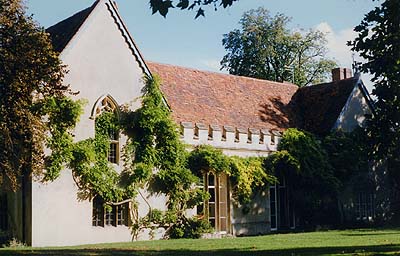
RBH Home
Maps & Travels
Articles
Legends
Towns & Villages
Castles & Houses
Churches
Biographies
Gentry
Family History
Odds & Ends
Mail David
 The
Abbey
The
AbbeySutton Courtenay, Berkshire
The oldest section of the 'Abbey' at Sutton Courtenay was built in the early 13th century by the great Benedictine Abbey of Abingdon. Abingdon Abbey had a strong local influence and extensive property in this area at the time. The 'Abbey' at Sutton was a monastic grange, used as an administrative centre for Abingdon Abbey's land and tithe holdings in the area. Being so close to Abingdon, it was probably run by the monks themselves rather than being left to a steward.
In 1284, the Abbey was handed over to the Courtenay family, Lords of the Manor of Sutton, in a dubious court trial. The building was then used, for the next two hundred years, as a rectory house. The West Range was added around 1290; and the great timber hall, that still survives to full height today, was clad in great blocks of stone when it began to lean about forty years later. As an elegant stone mansion, the 'Abbey' made the living at Sutton a very attractive one, luring many Royal clerks to the living: such men as the chaplains of the Black Prince and John of Gaunt, the doctor of Henry V and the secretary of King Henry VI: Thomas Beckington, who later became Bishop of Bath & Wells. Unfortunately, many of these men were so caught up with affairs of state that they rarely visited Sutton, leaving the running of the parish church to various underlings.
The South and East ranges at the 'Abbey' were completed around the middle of the fifteenth century, just before Thomas Courtenay, who was involved in the War of the Roses, was beheaded and had his lands confiscated. In 1485, King Henry VII gave the house and its income to the Dean and Chapter of St. George's Chapel in Windsor Castle. The 'Abbey' was then leased to local squires by St. George's for the next 350 years.
In 1900, the Abbey passed into private ownership. It was bought, in 1958, by David Astor (owner of the local manor house and publisher of the Observer), who leased it for a peppercorn rent to the Ockendon Venture for a Refugee Children's home. During this time, the Dalai Lama visited and received his fellow refugee Tibetans in the Great Hall. It was then lent, by David Astor, to the exiled Archbishop Colin Winter, to be used as the Namibia Centre in Great Britain.
In 1980, The Abbey was bought by a non-profit making charity, 'The New Era Centre'. A community was established here by Fred Blum and Bishop Stephen Verney. In the early 1990s, the charity was re-named 'The Abbey, Sutton Courtenay'. Rooted in the Christian tradition, yet open to the wisdom of other faiths, it continues to provide a setting for the exploration of deep spiritual truths and values, and the mystery of life.
The 'Abbey' at Sutton Courtenay
is currently a Community
Retreat and Conference Centre.
